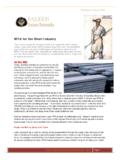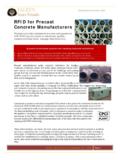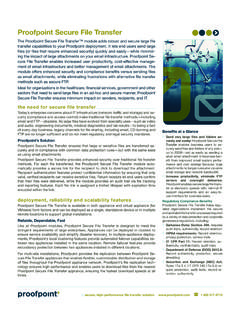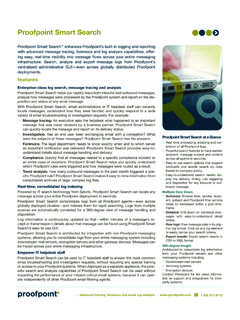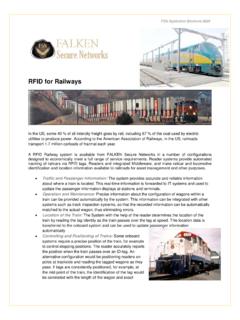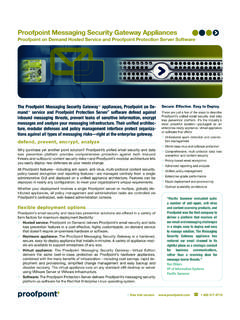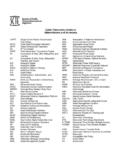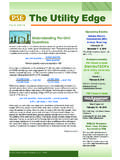Transcription of RFID for Pallet Tracking - Falken Secure Networks
1 FSN Applications Brochure 0816 Page 1 The radio-frequency identification ( rfid ) tags applied to opposite sides of the Pallet rfid for Pallet Tracking Many companies lease pallets and other logistics containers in order to offload the cost of maintaining their own Pallet fleet. However, managing the return of these items has often proven challenging for Pallet providers. Although many companies currently use cheaper wood pallets, demand for reusable plastic pallets has increased in recent years because of fears about cross-contamination from meat and other food products shipped on wooden pallets (which are often scrapped afterward), and new International Plant Protection Convention (IPPC) requirements for the fumigation of wood pallets to prevent the spread of invasive insects.
2 Plastic pallets also last longer and are lighter than their wood counterparts, which can save on freight costs. Think you have Pallet - Tracking problems? Svenska Retursystem (SRS) distributes more than one million plastic pallets throughout Sweden. Keeping track of each Pallet is a formidable, but essential, task. Deposits are required to cover costs should pallets be damaged or lost, and SRS was constantly running into problems with pallets being returned later than expected, or not at all. The outdated inventory system wasn't adequately keeping track of where pallets were being lost or damaged, resulting in SRS incurring the costs. A system for Tracking the pallets while they were in circulation was desperately needed. Bar code technology was proposed, but determined to be insufficient for the application for two reasons.
3 First, because these pallets are for carrying fresh produce, each Pallet re-entering the facility is treated with a variety of cleaning chemicals and high-pressure washing. Bar codes simply could not endure these conditions. Also, the life of any Pallet inevitably involves a significant amount of bumping and bruising, and even a small scratch can render a barcode useless. To provide real-time visibility of pallets in circulation, each Pallet was outfitted with a ruggedized tag that would remain with it for its entire lifetime. Instead of mounting these tags to the exterior of the Pallet (as is necessary with bar codes due to the line-of-sight requirement), engineers at Pallet manufacturer Arca System, Perstorp, Sweden, embedded the tags in the interior structure of the two-piece Pallet . Two tags are embedded inside opposite corners of the pallets to ensure that regardless of orientation on the conveyer, one tag will be picked up.
4 Once installed, the tags can be written to with information and read by the antenna. When the pallets complete a cycle, the tags are cleared and rewritten. Two plate antennas at the entrance to the Pallet -cleaning machine read the tags. Pallet history is downloaded for each Pallet , and if damage is evident, the proper customer is charged. Likewise, the pallets whose origin is unknown can be identified by reading the tags. FSN Applications Brochure 0816 Page 2 Pallets on the road In this application, pallets leave SRS and arrive at the warehousing hub of a major supermarket. Supermarket operators use a portable handheld scanner to read and write time and date stamp, as well as handling instructions, to the tag.
5 The pallets are then loaded with perishable goods, and the tags are written to with information such as product expiration date and storage instructions. The full pallets are then delivered to the neighborhood grocery store, where grocery workers scan them as they arrive to ensure freshness and quality. Empty pallets are loaded into the trucks and returned to SRS where they are again read. After relevant charges are processed, Pallet information is then cleared, and the tag is written to with date/time information for its next voyage out into the world. Results of the rfid system are impressive. Each Pallet has a self-contained recordkeeping system, eliminating the paperwork that is common with Pallet shipments. The combination of resilient rfid tags and reusable pallets is a cost-effective solution: wooden pallets and bar-code labels are both consumables, while plastic pallets and rfid tags are recycled and reused.
6 By accessing the shipment history of each incoming Pallet , SRS is able to recoup for lost and damaged pallets by having record of who was responsible for the product at any given time. Customers pay for the length of time they have the pallets as well, so usage costs can be immediately determined and charged. Theft, formerly a rampant problem, is greatly reduced with rfid . If a stolen Pallet reenters the facility, operators can determine when and where the Pallet was taken. rfid for other Pallet Providers Intelligent Global Pooling Systems (iGPS) has incorporated EPCglobal's electronic product code (EPC) into its rfid Tracking system, enabling its pallets to be identified worldwide. The royalty-free standards are the foundations in the continuing construction of a global supply chain information network that combines rfid technology, existing communications network infrastructure and EPC, a number for uniquely identifying an item.
7 EPC allows companies and regulators to share information, regardless of rfid technology used, thus speeding up the supply chain and reducing errors. With multiple imbedded rfid tags and visible barcodes in each unit, the pallets are 100 percent readable, even when stored near concrete or carrying liquids, which can disrupt some rfid readers, claims iGPS. The GRAI codes provide unique identification for each re-usable plastic Pallet when read by rfid readers, allowing transparent, real-time Tracking of every Pallet through the supply chain, claims the manufacturer. Bob Moore, chief executive officer of iGPS said use of the standards would streamline processes. "User information for each transaction is stored automatically in the system for easy recall based on the GRAI number, eliminating disputes and misunderstandings over when product is shipped and received.
8 " FSN Applications Brochure 0816 Page 3 How it Works iGPS' manufacturing partners embed rfid tags in the plastic pallets at the point of manufacture. The serial number encoded on the tags is then uploaded into the database before the pallets are shipped to iGPS facilities. The rfid tags in the pallets are based on the Electronic Product Code (EPC) Global Reusable Asset Identifier (GRAI) standard, which provides a unique identification for each Pallet . There are four tags in each Pallet to ensure readability. iGPS scans the tags at receipt using an rfid reader portal, hand-held reader, or forklift-mounted readers from Alien Technology and Motorola. Once a customer orders a shipment of pallets, they are scanned again on the outbound side before being handed over to a third-party logistics carrier for transportation to the customer.
9 After customers receive the pallets and load them with merchandise, the Pallet tags are scanned before being shipped to retailer locations. For customers who can't read the rfid tags, a non-removable bar code label (which also includes human readable information) is placed on the outside of the Pallet . Falken Secure Networks implementation to meet these types of multi-location operational requirements positions Network Edge servers from Omnitrol Networks running the Middleware and Application at the various customer depots and customer locations are used to collect data on the pallets. As the Pallet labels and rfid tags are scanned, the Omnitrol edge servers push that information up to the central Omnitrol system so that real-time data on the location of its pallets is immediately available. In this way, multiple locations are federated and provide one single real-time view of the entire operation.
10 After the volumes of data from readers are treated according to a customer definable business rules engine, the Omnitrol edge servers send data to the central Omnitrol server for consolidation, and that's passed to the back-end ERP system. Typically,the system would also transmit information to the edge servers at the customer depots to provide the schedule of orders and shipments that are about to come in at that location. Customer-configurable rules can be set up such that the system automatically sends an alert if a Pallet has gone missing. Using the Tracking data, a company can triangulate where the Pallet left the system. This provides enhanced asset control for both Pallet companies and its customers. Billing is also improved, since a more accurate record of Pallet use and loss is provided for each customer.
